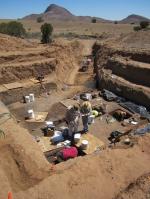Office of Contract Archaeology Director Robert Dello-Russo has been conducting research at the Paleo-Indian site of Water Canyon near Socorro, New Mexico since 2001. Dello-Russo and other archaeologists have recovered evidence of hunting activity dating from 13,000 to 9,000 years ago. Materials include projectile points and other stone tools, along with bison remains ranging from Clovis (~13,000 years ago), Folsom (~12,000 years ago), and Cody Complex (~10,800 years ago), as well as later Paelo-Indian peoples (~9,200 years ago). The site provides an opportunity to evaluate a wide range of research questions about the lifeways of these ancient inhabitants, including tracing the source of the materials used to manufacture the stone tools at the site. Another significant question is how bison evolved—the site has yielded Bison antiquus bones, a late Pleistocene species that pre-dates the smaller, modern Bison bison.
In the summer of 2015, students from a UNM undergraduate archeological field school worked at the site. The students learned how to excavate, document, and catalog the material. Dello-Russo is searching for graduate students to take back to the site for continued research.
http://news.unm.edu/news/uncovering-the-mystery-of-very-early-humans-in-new-mexico



